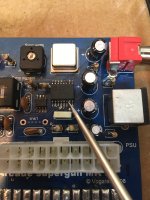Anyone comfortable replacing this chip?
It’s arcade PCB test equipment that isn’t being made anymore.... this version anyway.
My inferior diagnostic skills have me believing that this chip is the fault. Mouser sells them on the cheap.
I’m just not experienced enough to trust myself to swap it. I can remove most of the through hole stuff before hand in the area if that would help.
What would you charge? I’ll cover shipping both ways. I just want it done right.
Thanks!
~Tim
It’s arcade PCB test equipment that isn’t being made anymore.... this version anyway.
My inferior diagnostic skills have me believing that this chip is the fault. Mouser sells them on the cheap.
I’m just not experienced enough to trust myself to swap it. I can remove most of the through hole stuff before hand in the area if that would help.
What would you charge? I’ll cover shipping both ways. I just want it done right.
Thanks!
~Tim

